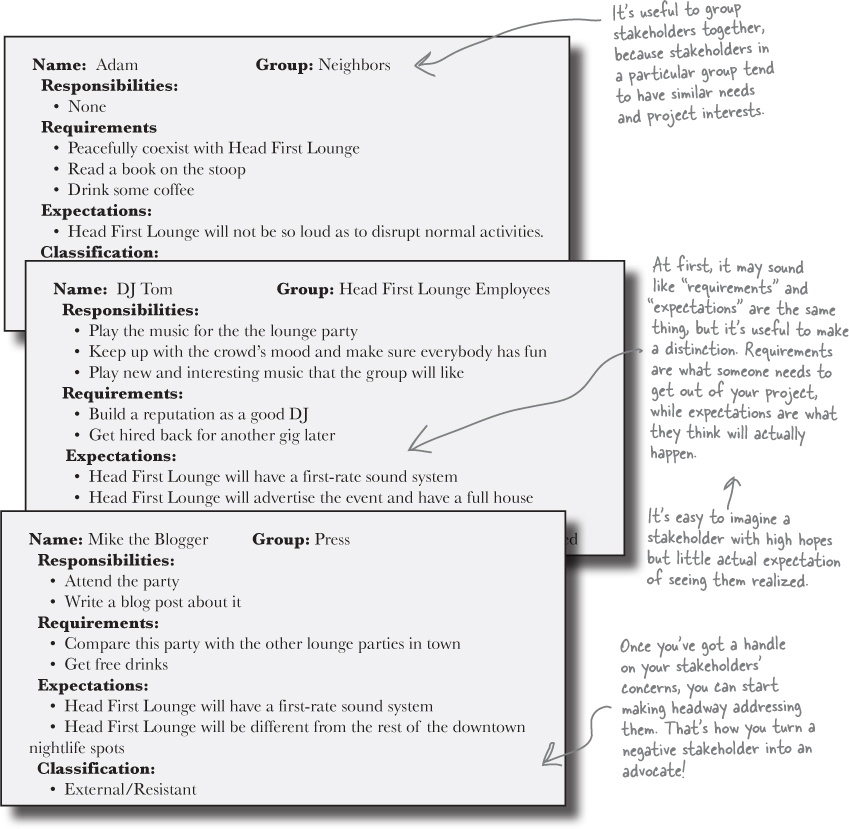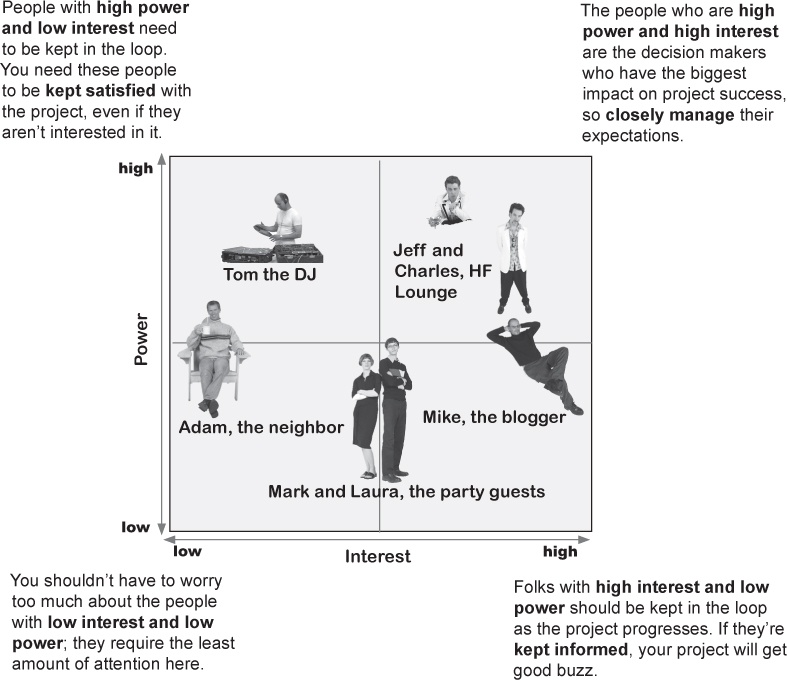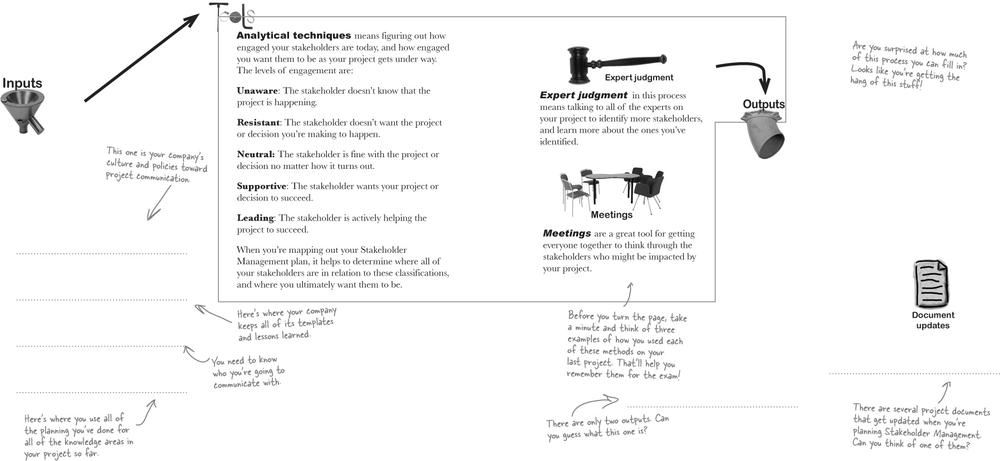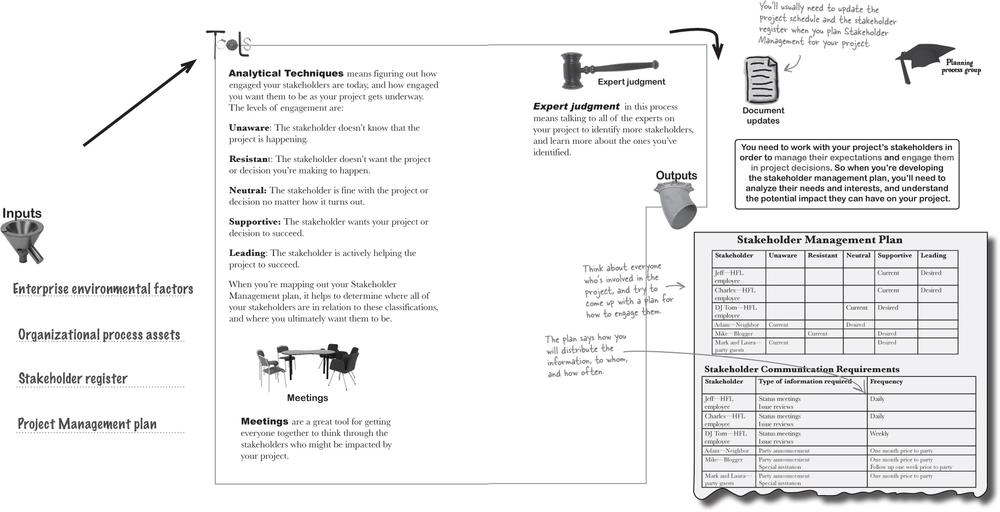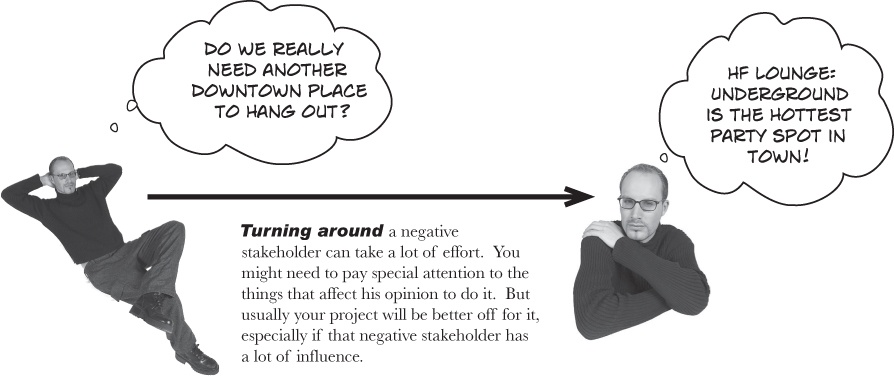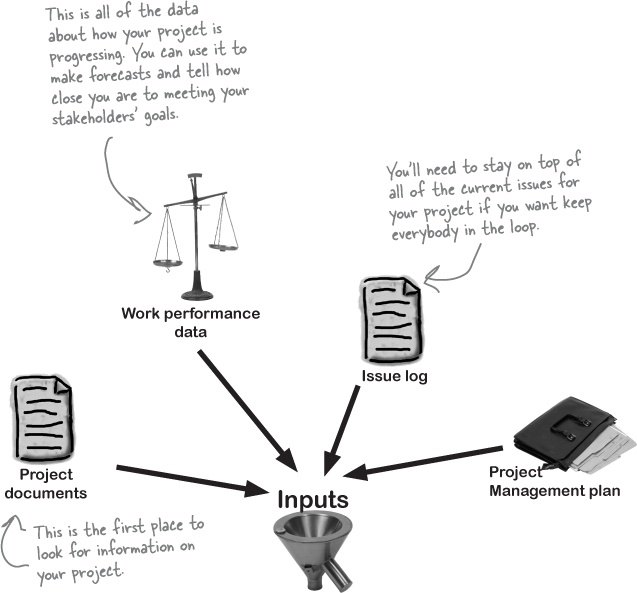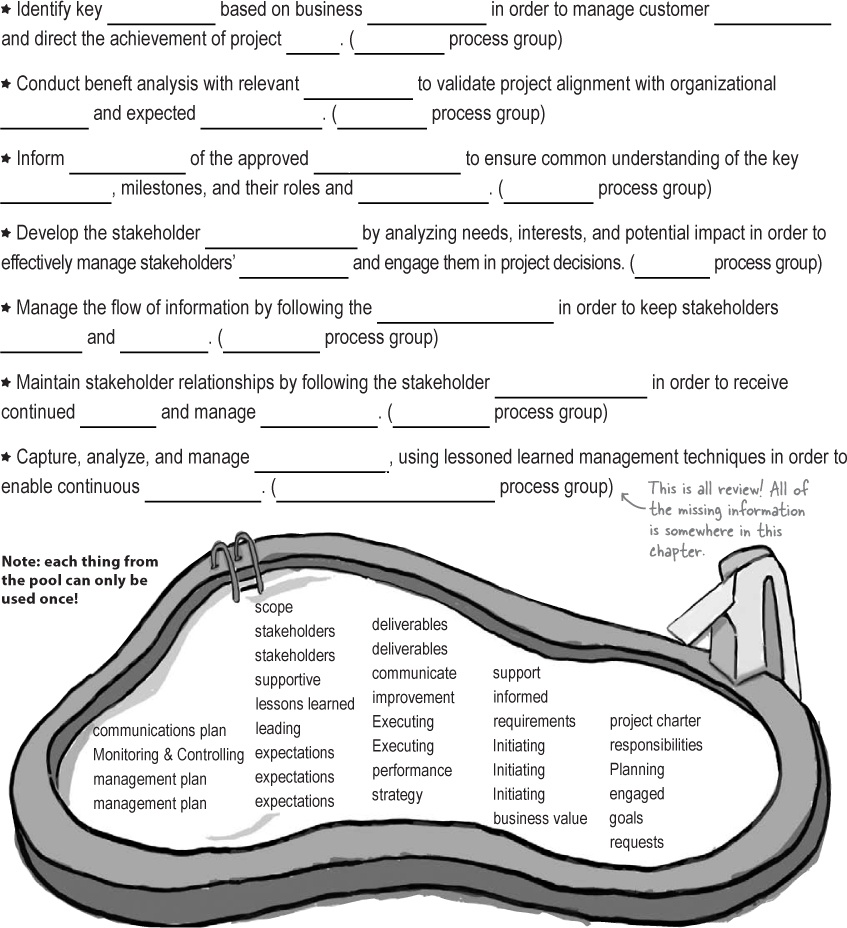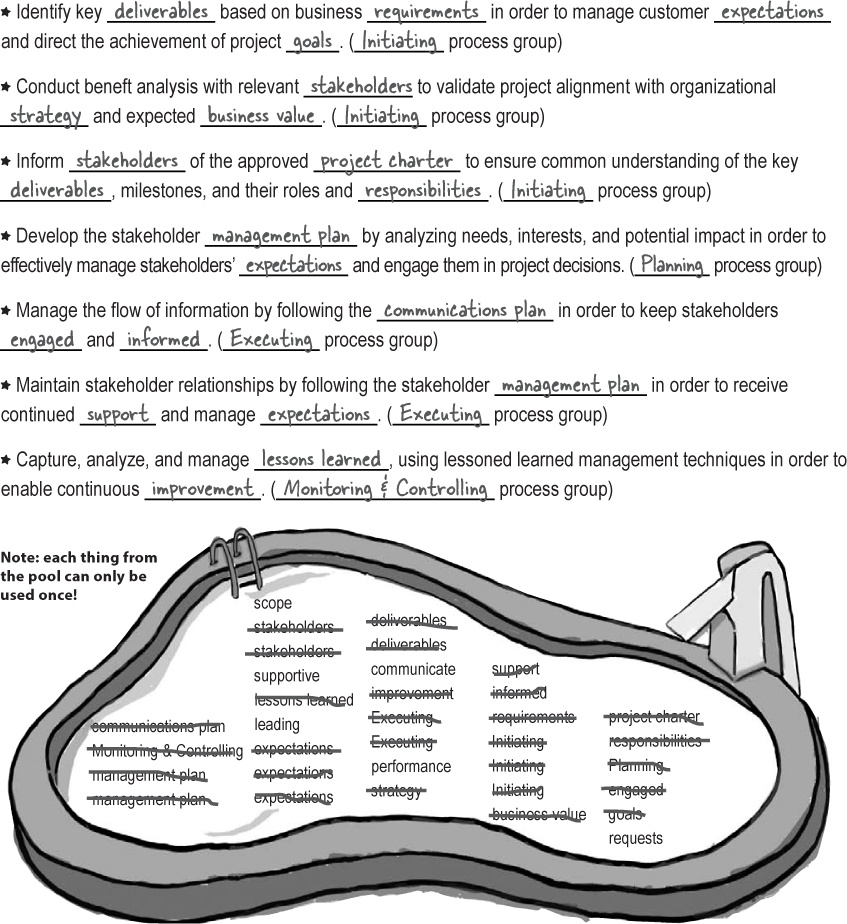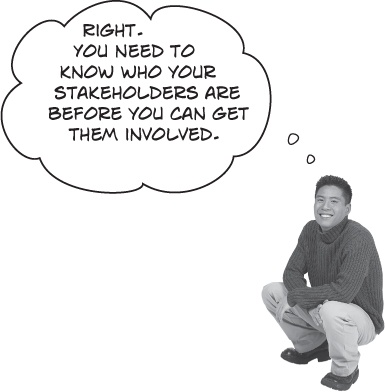Chapter 13. Stakeholder Management: Keeping everyone engaged
Project management is about knowing your audience. If you don’t get a handle on the people who are affected by your project, you might discover that they have needs you aren’t meeting. If your project is going to be successful, you’ve got to satisfy your stakeholders. Luckily, there’s the Stakeholder Management knowledge area, which you can use to understand your stakeholders and figure out what they need. Once you really understand how important those needs are to your project, it’s a lot easier to keep everyone satisfied.
Party at the Head First Lounge (again)!
Jeff and Charles had a great time upgrading the lounge in Chapter 10. They’ve been doing so well since they upgraded that they want to have another party to ring in the summer.
Not everybody is thrilled
There were a few people who weren’t quite as enthused about the opening party for Head First Lounge as Jeff and Charles were. Can you use the four Stakeholder Management processes to help them get their party on track?
Understanding your stakeholders
When you think about it, there are a lot of people who have an interest in your project. That obviously includes the sponsor who’s paying for it, the team who’s making it, and the people who will support it. But there are people who aren’t so obvious who have a stake in your project as well. If you don’t pay attention to all of your stakeholders, you could find that you don’t meet their needs, and that can cause your project to run off the rails. The Stakeholder Management processes are here to help you figure out who your stakeholders are, plan how you’ll keep them engaged, and manage your project to keep them satisfied.
Stakeholder Management makes sure you know who you need to engage to keep your project on track.
Find out who your stakeholders are
One of the first things you need to do when you start a project is to figure out who your stakeholders are and what you need to do to keep them all in the loop. The Identify Stakeholders process is all about writing down your stakeholders’ names along with their goals, expectations, and concerns in a document called the stakeholder register. Most projects succeed or fail based on how well the project manager knows and manages stakeholder expectations. Writing them down up front will help you to come up with a strategy to identify the people who could impact your project, but still need to be convinced of its value.
Tools
Behind the Scenes
Stakeholders are really important when you’re initiating a project. In Chapter 4 we learned about the business case document, which determines why the benefits of the project are worth the cost. How do you build that document? By working with stakeholders to analyze the benefits of the project, because the stakeholders are the people who understand the organization’s strategy, and can evaluate the expected business value of the project.
So what happens after the project charter is approved? The charter contains project requirements, milestones, and other important information about what the team will deliver. But it’s not enough to simply write it down. You need to communicate with the stakeholders to make sure they understand what’s in the charter, and their responsibilities.
Stakeholder analysis up close
When you get started on your project, the first thing you should do is examine the charter and any contract information you have to figure out who will be impacted by it. Once you have a preliminary list of stakeholders, you should sit down with each one of them and figure out their responsibilities, goals, expectations, and concerns. These interviews will be the basis for the stakeholder profiles in your stakeholder register. As you interview people, you’ll likely find more stakeholders to include in the list.
One way to get a handle on how to communicate with your stakeholders is to create a power/interest grid. When you plot your stakeholders on a power/interest grid, you can determine who has high or low power to affect your project, and who has high or low interest. People with high power need to be kept satisfied, while people with high interest need to be kept informed. When a stakeholder has both, make sure you manage her expectations very closely!
How engaged are your stakeholders?
It’s not enough to know who your stakeholders are—you need to understand what motivates them, and what it will take to make the project a success for each of them. That’s where the Stakeholder Engagement Assessment matrix comes in. Jeff and Charles sat down and worked to come up with one for their upcoming party. Here’s what it looked like:
Stakeholder | Unaware | Resistant | Neutral | Supportive | Leading |
Jeff—HFL employee | Current | Desire | |||
Charles—HFL employee | Current | Desired | |||
DJ Tom—HFL employee | Current | Desired | |||
Adam—Neighbor | Current | Desired | |||
Mike—Blogger | Current | Desired | |||
Mark and Laura—party guests | Current | Desired |
Brain Power
Think about a major project you’ve worked on where there were a large number of stakeholders. Where was their engagement level at the beginning of the project? Where did it end up?
There are five engagement levels for stakeholders; unaware, resistant, neutral, supportive, and leading.
Managing stakeholder engagement means clearing up misunderstandings
As your project progresses, you’ll need to check in with your stakeholders regularly so that misunderstandings don’t develop. Your job is to help them to take part in the decisions the team is making, so that they can be supportive. When a stakeholder is resistant to change, you’ll need to negotiate with her and understand her resistance so that you can take her perspective into account.
Sometimes a stakeholder you don’t always talk to might have a good suggestion for improvement that can help the whole team. It’s also possible that there are some facts about the project that the stakeholder hasn’t considered, and you can help him to be better informed. The key to success in Stakeholder Management is being inclusive, and sharing information with everyone who’s impacted by the project’s outcome.
Jeff and Charles didn’t realize that they scheduled their party on the same day as another music event that was happening in the city. The sound engineers needed to bring in extra help to handle both events, and that’s why they were charging a bigger fee. Once you found out what the issue was and communicated it back to the Head First Lounge team, they understood the cost and approved it.
Control your stakeholders’ engagement
Monitoring and Controlling process group
Now that you’ve got a great framework set up for managing the way your stakeholders interact with your project, you need to monitor those interactions to make sure that everybody stays in the loop. When you run into a problem or find a place where you might be able to bring the project closer to meeting a stakeholder’s goal, you can make course corrections and changes to keep as many of your stakeholders satisfied as possible—and that’s what the Control Stakeholder Engagement process is all about.
Once you know what your stakeholders’ requirements are, you can monitor how close or far away your project is from meeting them.
Now you can tell when you need to change the way you deal with stakeholders
Now that you’ve taken a look at all of the data coming from your project, you’re in a better position to tell if you need to make changes to the way you’re managing stakeholder engagement. The outputs from Control Stakeholder Engagement are all about making changes to the documents you’ve been using to keep them engaged all along.
Work performance information is the analyzed work performance data, changed from raw data into reports that are understood in context and can be used to make project decisions. Where work performance data was the raw outputs of the various controlling processes, the work performance information is consolidated. Think of work performance data as your raw budget performance data (this month, we’re over budget by $1,000) and work performance information as that data in context (the project budget forecast is currently $10,000 under budget, even though we’re over by $1,000 this month).
Change requests happen as part of controlling stakeholder engagement. What do you do if you find out that one of your stakeholders’ requirements has been missed? You put the change request in as soon as possible.
Project documents updates happen as you work with your stakeholders to monitor and control their engagement. You might find new stakeholders along the way who make you update your stakeholder register. You could also run into issues that need to be added to the issue log.
Project Management Plan updates might be needed as you work with your stakeholders to ensure successful delivery. Your stakeholders might request changes to your overall strategy for any of the knowledge areas you’ve planned as part of your Project Management plan. You’ll need to go back and make updates to those plans if you want to keep everyone in the loop about the change in approach.
It’s party time!
The Head First Lounge party is a big hit! Thanks to your Stakeholder Management skills, Jeff and Charles are the reigning kings of downtown nightlife!
Exam Questions
1. Answer: D
Since Matt is working to bring other stakeholders to support the project, he’s in a leading engagement role.
2. Answer: C
Work performance data is an input of some Stakeholder Management processes, but not an input to Plan Stakeholder Management.
3. Answer: A
The stakeholder register is the first thing you need to create here. It looks like some of the upper managers who might be thinking of cancelling the project need to have their ideas taken into account. Once you’ve identified them as stakeholders, you can work to bring their perspective into account on your project and include them in project management decisions.
4. Answer: A
It sounds like this stakeholder is completely unaware of her responsibilities on the project. The next step here is to spend some time bringing her up to speed on what’s expected.
5. Answer: C
When you look at work performance data and discover a new stakeholder requirement, you’re doing the Control Stakeholder Engagement process. Some of the outputs of that process are change requests, project document updates, and Project Management plan updates.
Note
Once you recognize the process that’s being described, try to think of the outputs of the process to figure out which answer is best.
6. Answer: B
Stakeholders in the low power/high interest quadrant of the power/interest grid need to be kept informed of all project decisions.
7. Answer: B
Identify Stakeholders is the only process in Stakeholder Management that is part of the Initiating process group.
Note
Flip back to Chapter 3 for a quick refresher on the Initiating process group, now that you’ve studied Stakeholder Management. It’s a good way to review.
8. Answer: B
Stakeholders in the high power/high interest quadrant of the power/interest grid need to have their expectations and requirements closely managed by the project manager.
9. Answer: D
The Project Management plan is not an input to the Identify Stakeholders process. Since the Identify Stakeholders process is part of the Initiating process group, the stakeholders are identified as an input to the Planning processes that create the Project Management plan.
Note
It can get confusing because Identify Stakeholders is discussed at the end of the PMBOK Guide, but it’s part of the Initiating processes and done before you get to the Planning processes.
10. Answer: A
This is a stakeholder expectation. The stakeholder expects that the team will do as requested.
11. Answer: D
Not all stakeholders have deliverables on a project. Some are sponsors, vendors, or others who might be involved in the project but not actually producing deliverables. When a stakeholder does have deliverables that she’s accountable for, she’ll be documented in the Scope Management plan.
12. Answer: D
Control Stakeholder Engagement is the only Monitoring and Controlling process in Stakeholder Management.










